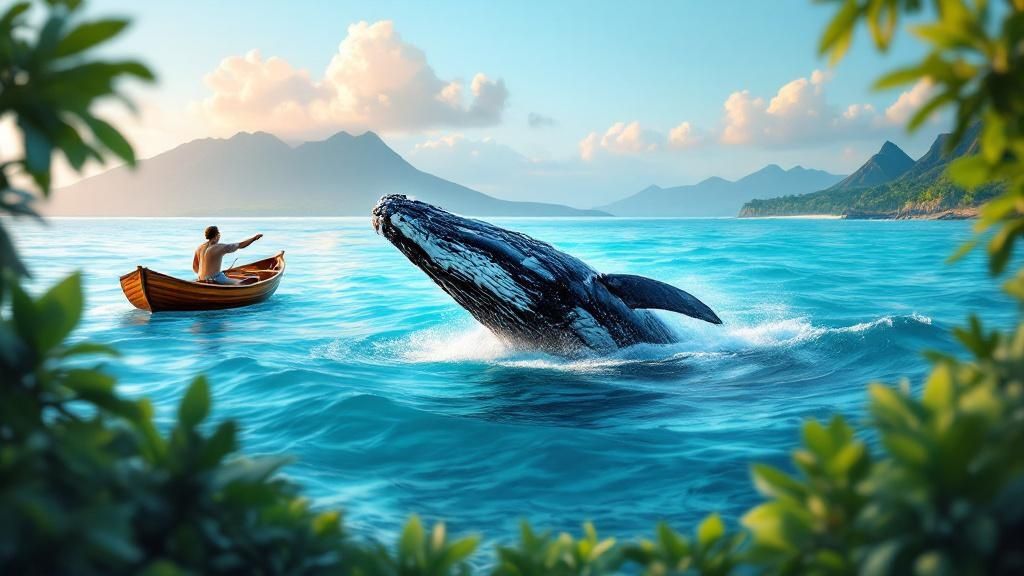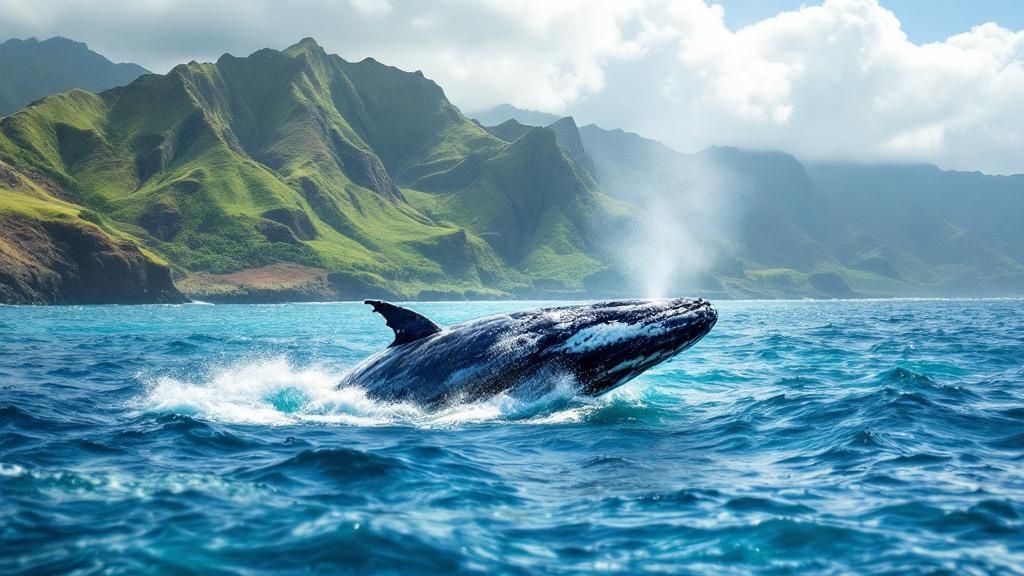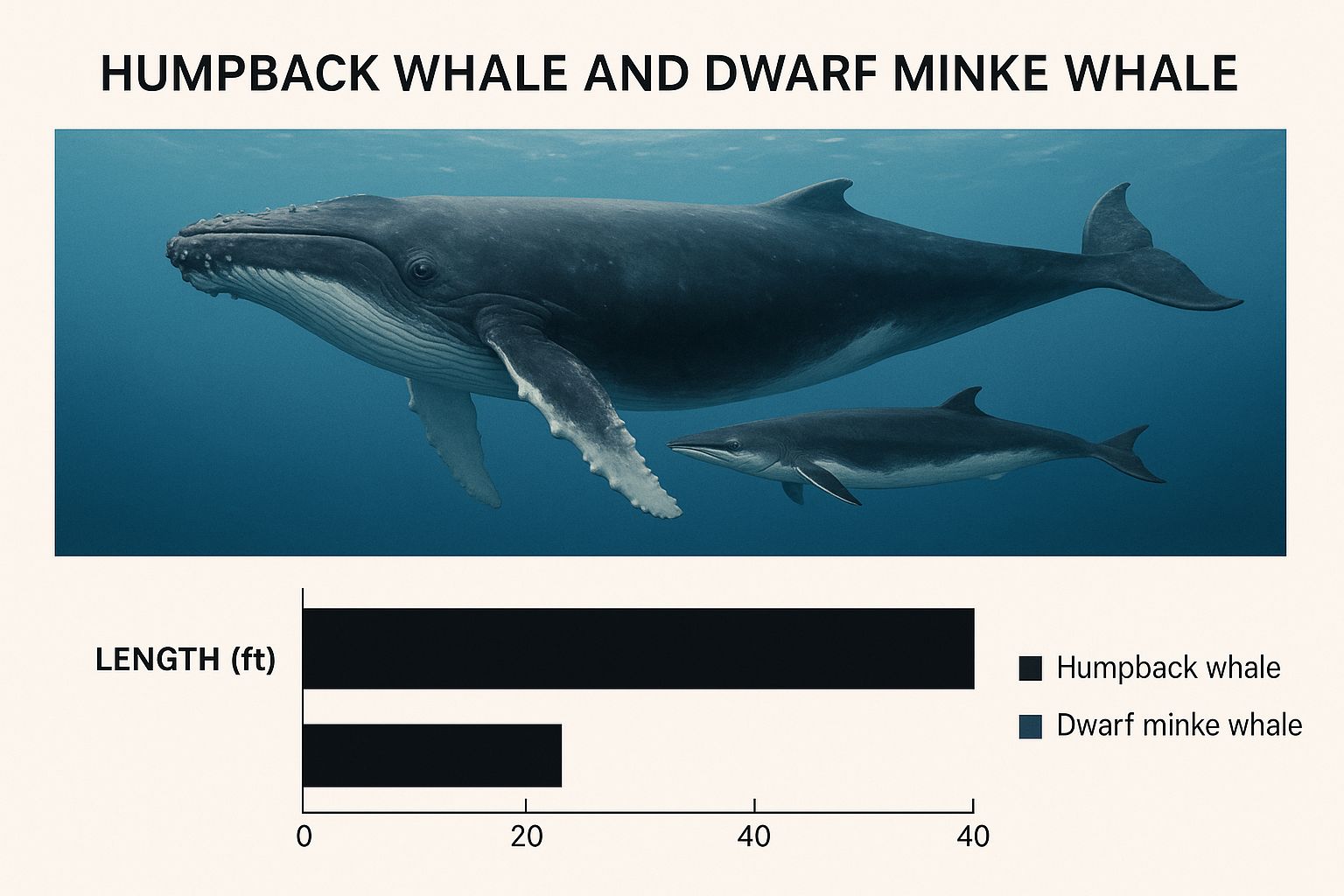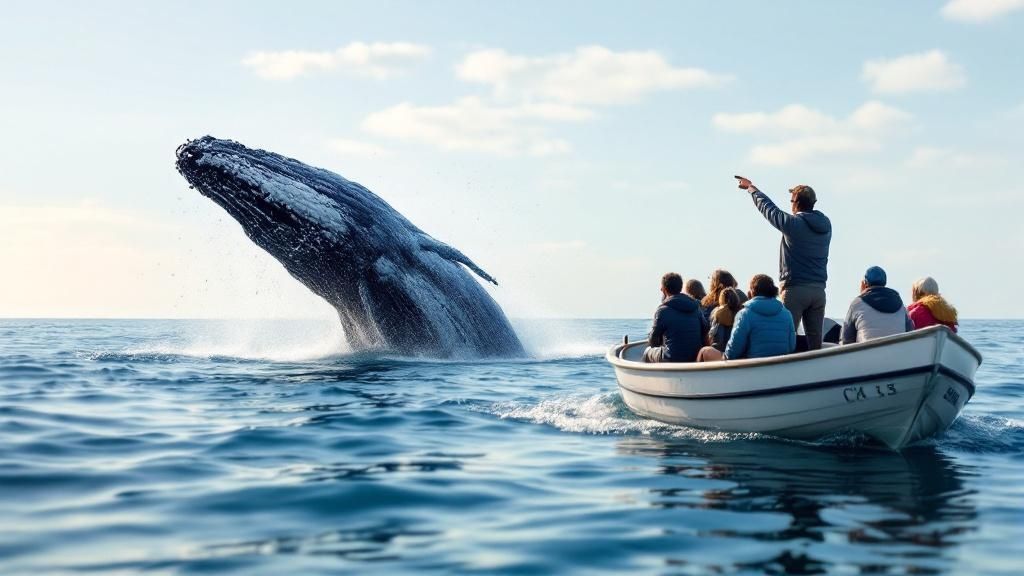Your Guide to Whale Season Hawaii

If you want to experience the absolute best of whale season hawaii, you’ve got to plan your trip between January and March. It’s true that the first humpback whales start showing up in December and a few stragglers hang around into April, but that three-month window is the real magic. It's the absolute peak, with the highest concentration of whales and the most jaw-dropping activity you can imagine.
Understanding the Heart of Whale Season
Every winter, something incredible happens. Thousands of North Pacific humpback whales make the epic journey from their frigid feeding grounds in Alaska all the way to the warm, protected waters of Hawaii. This isn't just a tropical vacation for them; it’s a critical part of their life cycle. The Hawaiian Islands are their chosen destination for breeding, giving birth, and nursing their newborn calves.
Think of Hawaii during these months as a massive, open-ocean nursery. The shallower, warmer waters offer a safe haven from predators like killer whales and provide a gentle environment for the calves, known as koholā, to grow strong before their long swim back north. Witnessing this annual migration is truly one of nature's greatest shows.
To give you a clearer picture, here's a quick breakdown of how the season unfolds:
Hawaii Whale Season at a Glance
| Time Period | Whale Activity Level | What to Expect |
|---|---|---|
| November – December | Low to Moderate | The first arrivals! You'll start seeing a few whales, mostly scouts and early arrivals. Sightings are less frequent. |
| January – March | High (Peak Season) | This is it! The highest density of whales. Expect frequent breaches, tail slaps, and mother-calf pairs. The absolute best time to go. |
| April – May | Moderate to Low | The last of the whales are heading back to Alaska. You can still catch some activity, but sightings become less common as the month progresses. |
This table shows why timing your trip is so crucial. While you might see whales outside the peak window, your best bet for an unforgettable experience is right in the middle of the season.
Why Timing Is Everything
Showing up at the right time completely changes the game. It dramatically boosts your odds of seeing the kind of spectacular behaviors that people talk about for years. During the peak months, the sheer number of whales creates an incredibly dynamic and active scene.
- So Many Whales, So Little Time: With more whales packed into the channels, you'll get more frequent sightings, whether you're on a boat or just watching from the shoreline.
- The Competition Heats Up: This is breeding season, and male whales compete for the attention of females. This leads to those breathtaking displays you see on documentaries—powerful breaches, pectoral fin slaps, and thunderous tail slaps.
- A Glimpse into the Nursery: It’s the best time to see mothers tenderly guiding their brand-new calves. Watching a baby whale learn the ropes is a truly moving experience.
The energy during this time is palpable. To put it in perspective, the first coordinated count of the 2025 season on January 25 saw volunteers spot an incredible 2,121 humpback whales in just one day. It’s a powerful snapshot of just how vibrant this population is. You can dive into more data from this amazing community effort on Maui Now.
Think of the peak season from January to March like a music festival. Sure, the gates are open for a few months, but all the headliners are on stage during this prime window, delivering one unforgettable performance after another. Booking your adventure for these months is like getting a front-row seat to the greatest show in the ocean.
Why Hawaii Is a Global Whale Watching Hotspot

Sure, you can spot humpback whales in other places around the globe, but there's a reason Hawaii is in a league of its own. This isn't just another stop along their migration route; for many, it's the final destination. Every winter, an incredible 12,000 humpback whales make the 3,000-mile journey from the chilly waters of Alaska to the Hawaiian Islands, creating one of the most vital habitats for the entire North Pacific humpback population.
So what makes these islands so irresistible to them? It’s a perfect storm of geography and protection that creates the ultimate sanctuary for one of nature’s most spectacular events. Just picture the ocean surrounding the main islands as a giant, warm, and sheltered nursery—a safe harbor where the next generation of giants takes its first breath.
The Ideal Marine Nursery
The secret to Hawaii's magic lies in its unique underwater landscape. Unlike the deep, vast open ocean, the waters here are relatively shallow, warm, and remarkably clear. These are the exact conditions a mother humpback needs to give birth and raise her newborn calf.
A baby humpback is born weighing around 2,000 pounds and measuring about 15 feet long. They don't have the thick, insulating layer of blubber that adults do, which makes the balmy Hawaiian waters absolutely critical for their survival during those first few vulnerable weeks.
The shallow waters, often less than 600 feet deep around the islands, provide a natural defense against deep-water predators like orcas. This gives mothers the peace of mind to focus on nursing their young and teaching them essential survival skills without constant fear.
This protected environment is precisely why the Hawaiian Islands Humpback Whale National Marine Sanctuary was created. Spanning over 1,400 square miles of prime whale territory, it ensures these magnificent animals have a federally protected space to thrive. The calm, safe conditions you experience during whale season hawaii are a direct result of both this natural geography and dedicated conservation.
A Deep Cultural Connection
For Hawaiians, the significance of the whales, or koholā, goes far deeper than just a wildlife spectacle. In Native Hawaiian culture, the koholā are revered beings. They are considered ʻaumākua—family guardians or ancestors who have returned to the living in a different form.
This profound cultural respect shapes the entire whale watching experience here. You'll find that tour operators and locals treat the whales with a deep-seated sense of stewardship and reverence. It’s not just about getting a good photo; it’s about honoring a sacred presence.
This connection adds a powerful layer to any whale watching trip. You aren't just an observer of animals; you're witnessing a culturally significant event that has been woven into the fabric of the islands for centuries. It's this beautiful blend of natural wonder and cultural depth that truly makes Hawaii the world's premier whale watching hotspot.
Choosing the Best Island for Your Whale Adventure
While you can technically spot whales from any Hawaiian island during the peak months, they definitely play favorites. Think of it like a massive migration highway system; some routes are just quiet backroads, while one is a bustling, jam-packed interstate. For the humpback whales heading to Hawaii, that interstate is the Auʻau Channel, making one island the undisputed king of whale season.
That island is Maui. Its magic lies in its geography. Nestled between the islands of Lānaʻi and Molokaʻi, Maui’s western shores form a shallow, warm, and incredibly protected body of water. This channel becomes a sanctuary, attracting the single highest concentration of humpback whales in the entire state. The calm conditions are absolutely perfect for mothers to give birth and nurse their newborn calves, leading to some of the most frequent and intimate sightings you can imagine.
This image really drives home the sheer size of a humpback compared to other whales. It puts their incredible scale into perspective.

When you see them side-by-side like this, it’s easy to understand why the breach of a 40-ton humpback is one of nature's most breathtaking spectacles.
Whale Watching Island Comparison
To help you decide, let's break down what each of the main islands has to offer. While Maui is the epicenter, you can have amazing encounters all over the state.
| Island | Primary Viewing Area | Best For | Typical Experience |
|---|---|---|---|
| Maui | Auʻau Channel (West Maui) | Highest whale density, frequent mother/calf sightings | "Whale soup"—non-stop action, often close to shore. |
| Big Island | Kohala Coast (Kona-Hāwī) | Rugged adventures, deep-water encounters | Fewer boats, dramatic volcanic backdrops. |
| Kauaʻi | Poʻipū (South Shore) | Stunning scenery, less crowded tours | Epic views of the Nāpali coast with whale sightings. |
| Oʻahu | Waikīkī to Makapuʻu Point | Convenience and accessibility from Honolulu | Easy to fit into a busy itinerary with plenty of tour options. |
Each island offers a unique flavor for your whale-watching trip. Your best choice really depends on what kind of adventure you're looking for.
Maui: The Epicenter of Activity
For sheer numbers and close encounters, Maui is simply in a league of its own. The leeward side of the island, from Lahaina down to Wailea, gives you a front-row seat to the show. It's not at all unusual to spot dozens of whales on a single two-hour boat trip.
The Auʻau Channel is so thick with activity that it's often called "whale soup." It’s the closest you can get to a guaranteed spectacular show, with breaches, tail slaps, and mother-calf pairs visible from almost anywhere along the coast.
The numbers back this up year after year. During one 2024 survey, volunteers on Maui counted an incredible 802 whales—nearly double the count of the next closest island.
Other Great Island Options
Even though Maui wears the crown, you can still have absolutely fantastic whale-watching experiences on the other islands. Each one brings a different vibe and its own unique viewing opportunities to the table.
-
The Big Island: The Kohala Coast, especially the stretch between Kona and Hāwī, is the prime spot here. The deep offshore waters attract whales, and the tours often have a more rugged, adventurous feel. It's a great place to mix whale watching with other ocean adventures. If that sounds like your kind of trip, you might want to check out our guide on the best Big Island snorkeling tours.
-
Kauaʻi: On the Garden Isle, head for the southern shore around Poʻipū for your best chance at sightings. The dramatic cliffs and lush coastline create a jaw-dropping backdrop for spotting whales. You might see fewer whales than in Maui, but the scenery makes every single sighting feel truly epic.
-
Oʻahu: The southern and eastern shores, from Waikīkī past Diamond Head and up toward Makapuʻu Point, are the main viewing areas. For many visitors, the big draw is the convenience of tours leaving right from Honolulu, making it simple to squeeze a whale-watching trip into a packed vacation.
Ultimately, it all comes down to your travel style. If this trip is all about the whales, Maui is your clear winner. But if you want to combine great whale watching with the unique culture and landscapes of another island, you’ll find incredible opportunities across the entire archipelago.
How to Select the Perfect Whale Watching Tour

Choosing the right tour can genuinely make or break your whale watching experience during whale season hawaii. With so many boats heading out each day, knowing what to look for transforms a good trip into an unforgettable one. It’s not just about hopping on a boat; it’s about finding the adventure that perfectly fits your style and what you hope to see.
The first big decision you'll make is the type of boat you go out on. This choice completely shapes the feel of your tour, from how smooth the ride is to just how close you get to the water's surface. Each vessel offers a totally different perspective on the incredible show the humpbacks put on.
Comparing Your Vessel Options
Think about what you want your day on the ocean to feel like. Are you picturing a smooth, relaxing ride with the whole family, or are you craving a faster, more intimate encounter with the waves?
-
Large Catamarans: These are the workhorses of the whale watching world. They’re incredibly stable, which makes them a fantastic choice for families with young kids or anyone who gets a little seasick. They usually have shaded areas, bathrooms, and even snack bars, so comfort is the name of the game.
-
Zodiac-Style Rafts: If you’re an adventure-seeker, these rigid-hulled inflatable boats deliver a fast-paced, thrilling ride. You're much closer to the water, feeling every wave and getting a unique, eye-level view of the whales. Because they're smaller, the group size is more intimate, too.
-
Sailboats: For a quieter, more peaceful experience, sailboats let you listen for the whales without the constant drone of a motor. It’s a truly serene way to connect with the ocean, though you should expect the tour to be a bit longer since you’re moving with the wind.
Beyond the boat itself, the quality of the crew and the company is what really separates a great tour from a forgettable one. A fantastic crew does more than just drive the boat; they provide context, education, and a deep respect for the animals you’re all there to see.
A key sign of a top-tier operator is having an on-board naturalist. This expert can decode whale behaviors in real-time—explaining the difference between a competitive breach and a casual tail slap. They often use a hydrophone, dropping it into the water so you can listen to the hauntingly beautiful songs of the whales live. It's a game-changer.
What to Look For in a Tour Company
Finally, focus on responsible practices and the nitty-gritty details. A reputable company will always put the whales' well-being first, strictly following the 100-yard approach distance required by federal law. This respect ensures the animals aren't stressed and can go about their business in their natural home.
When you're booking, keep in mind that early morning tours often have the calmest water. For the trip itself, be sure to pack the essentials: reef-safe sunscreen, polarized sunglasses to cut the glare, a hat, and a light jacket for the breeze on the water.
If you’re planning a trip from the Big Island, you can find excellent guidance and book directly with a trusted operator for a whale watching Kona tour that ticks all these boxes. Doing a little research on the different options will help you pick the perfect adventure. For example, check out these top whale watching tours in Kona on the Big Island.
Spotting Whales from Shore for Free
Believe it or not, you don't have to spend a dime or even step onto a boat to feel the magic of whale season in Hawaii. The islands are loaded with incredible lookout points where you can see the whole show with your feet planted firmly on solid ground. This is the perfect way to go for travelers on a budget, families with young kids, or anyone who just prefers a land-based adventure.
Many of the best viewing spots are tucked away in scenic areas you might be visiting anyway. On Maui, the McGregor Point Lookout gives you a panoramic cliffside perch right over the bustling Auʻau Channel. Over on Kauaʻi, the Kīlauea Point National Wildlife Refuge provides a jaw-dropping backdrop where you can spot whales and rare seabirds at the same time. All it really takes is a bit of patience and a good vantage point.
Your Shore-Sighting Toolkit
To get the most out of your free whale-watching experience, a few simple tools and tricks can make a world of difference. Think of it like gearing up for a nature hike—having the right equipment just makes the whole adventure better.
- Bring Binoculars: This is the most important tip, hands down. A good pair of binoculars brings the action so much closer, turning what looks like a distant splash into a crystal-clear view of a massive tail slapping the water.
- Scan the Horizon: Don't just get tunnel vision and stare at one spot. Slowly scan the ocean surface, moving your eyes back and forth. You're looking for anything that breaks the normal pattern of the waves.
- Look for the Spout: Often, the very first sign of a whale is its "spout" or "blow." This is the misty plume they create when they exhale at the surface, and from a distance, it can look just like a puff of smoke on the horizon.
Once you see a spout, keep your eyes glued to that area. Whales usually come up for air a few times before taking a deeper dive, which means you'll have several chances to watch them.
The commitment to watching from shore is so strong here that it actually forms the backbone of community science efforts. These volunteer counts provide invaluable data on whale populations and behaviors all season long.
Tracking the Whales from Land
This hands-on approach by local volunteers plays a huge part in conservation. For instance, the final official whale count of the 2025 season wrapped up on the last Saturday of March, with volunteers tallying an amazing 714 humpback whales from lookout points across the islands. This included 28 whales spotted from just eight sites on the Big Island alone, which really shows you how much action you can catch from the shoreline. You can learn more about how these community counts work over at Big Island Video News.
While seeing the whales is an absolute must-do, the Big Island is home to other mind-blowing marine encounters. For another unforgettable adventure, check out the magical world of manta ray snorkeling on the Big Island for an experience you'll never forget.
Alright, let's get all your whale watching questions sorted out. Think of this as the final checklist before you head out on the water, making sure you know exactly what to expect. We've gathered the most common questions we hear from guests to give you quick, clear answers.
What Is the Absolute Best Month to See Whales in Hawaii?
While you've got a great shot anytime from December through April, February is hands-down the peak of the season. This is when the party is in full swing. The whale population hits its max as the latecomers finally arrive, and calving season is at its most active.
Basically, you've got the highest odds of seeing the most whales and the widest variety of behaviors. Think of it as the grand finale of their migration. More whales mean more action—from those jaw-dropping breaches to the tender moments between a mother and her brand-new calf. Tours fill up fast this month, so I’d strongly suggest booking your trip well in advance to lock in a spot.
The peak whale season hawaii in February gives you the highest concentration of whales, maximizing your chances of seeing spectacular surface activity. It's the month when everything aligns for the most action-packed and memorable encounters.
Can I Swim with the Whales in Hawaii?
No, and this is a really important one. It is illegal to intentionally swim with, approach, or touch humpback whales in Hawaii. Federal and state laws are crystal clear: all boats and people—that includes swimmers, snorkelers, and even paddleboarders—have to stay at least 100 yards away from humpbacks.
These rules are there for a very good reason: to protect both the whales and us. The whales are in Hawaii for the incredibly important business of breeding and giving birth. The last thing they need is to be disturbed.
Any tour operator worth their salt will follow these guidelines to the letter, ensuring the animals' well-being is the top priority. It's an absolute privilege to witness these gentle giants, and respecting their space is part of that honor. The best and safest way to see them is from the deck of a responsible tour boat.
What Other Marine Life Might I See During a Tour?
While the humpbacks are definitely the main event, a whale watching tour often turns into a full-blown marine safari. The waters around the islands are just teeming with other amazing creatures.
It’s super common to run into big pods of spinner dolphins, famous for their incredible acrobatic leaps. You might also spot some curious bottlenose dolphins or the more elusive spotted dolphins. But that's not all. Keep your eyes peeled for:
- Hawaiian Green Sea Turtles (Honu): You'll often see these beloved turtles popping up for a breath or just chilling near the coast.
- Pilot Whales: It's not an everyday thing, but spotting these larger toothed whales is a serious thrill.
- Hawaiian Monk Seals: These guys are one of the most endangered seal species on the planet, so seeing one lounging on a quiet beach is a truly special moment.
Every single trip is different, and that element of surprise is a huge part of what makes a day on the water so magical.
What Are the Most Common Whale Behaviors to Look For?
Watching the whales is way more exciting when you have an idea of what they're up to. Any good guide will be narrating the action, but here are a few key behaviors to watch for:
- The Blow (or Spout): This is usually the first sign a whale is in the area. It’s that misty spray you see when they exhale warm air from their lungs. A humpback's spout can shoot up to 15 feet high!
- Pec Slap: You'll see a whale lying on its side, repeatedly slapping one of its long pectoral fins on the water. It makes a surprisingly loud crack and is thought to be a way they communicate.
- Tail Slap: Just like it sounds, a whale will slam its massive tail flukes on the water, kicking up a huge spray. It's another powerful form of communication.
- Spyhopping: This is a fun one. The whale will poke its head straight up out of the water, almost like it's trying to get a better look at you and the boat.
- The Breach: This is the money shot. A whale launching its enormous 40-ton body almost completely out of the water before crashing back down. It’s a pure, unforgettable display of power and grace that will stick with you forever.
Ready to witness the magic of whale season hawaii for yourself? At Kona Snorkel Trips, our small-group tours and expert, lifeguard-certified guides ensure you have a safe, respectful, and unforgettable adventure. Book your trip with us today!
